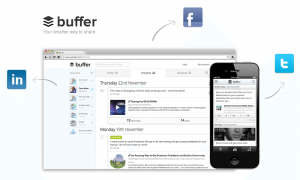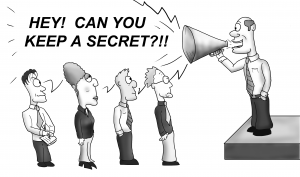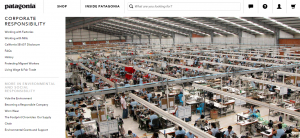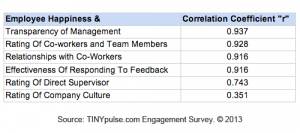Social media has created a whole new world of information sharing—from product reviews, to pop culture commentary, to a person’s innermost thoughts, including what he or she had for lunch that day. As a result, the threshold for what information is considered need-to-know has been lowered considerably.
Transparency has evolved into an expectation, no longer a perk or a quality reserved for personal interactions. Transparency is now a staple of a successful business model, seeing as audiences are much savvier and quicker to distrust, so businesses can no longer get away with withholding information or being plainspoken only to right a wrong. Companies need to build transparency into their everyday dealings and interactions.
Transparency: More Than Just A Buzzword
Experts Exchange: “In its simplest sense, business transparency means clear, unhindered honesty in the way that [a company] does business. But it’s more than that. One business dictionary defines transparency as a ‘lack of hidden agendas or conditions, accompanied by the availability of full information required for collaboration, cooperation, and collective decision making.’
The same source describes it as an ‘essential condition for a free and open exchange whereby the rules and reasons behind regulatory measures are fair and clear to all participants.’ Meanwhile, another source defines transparency as ‘the full, accurate, and timely disclosure of information.’
In other words, business transparency is more than simple honesty—much more…For example, if a company engages in a practice that costs its members or shareholders money, but doesn’t admit its responsibility for the loss until years later, that is not transparent behavior, regardless of how completely the company discloses the details of its behavior.
Unfortunately, there are some detractors who prefer that transparency retain its more strategic character, and perhaps even be thought of as a burden on companies as a result of increased regulatory constraints. Although it’s true that the messaging of transparency ought to be mended into the communication strategy of every business, it is precisely this mindset that makes this discussion so necessary.”
Don’t Be Evil
Transparency and vulnerability are two peas in a pod, which is why many companies fear and stress over becoming more transparent. With transparency comes a nakedness, exposing your company for what it truly is and how it works to both your customers and employees.
And so, for those companies preoccupied with what if scenarios (What if we mess up? What if revenue decreases? What if we have layoffs?) or those whose operations are a little rocky, then, yes, transparency can be not only nerve-wracking but also disastrous
If you treat your customers and employees well, however, and if you’re open to reflecting on your values and assessing how you can improve, then transparency is simple and it can provide your company with a number of advantages.
Buffer.com is one such company that has taken great strides towards making transparency one of its “deepest values.” Leo Widrich, Co-Founder of Buffer, cites transparency as being “absolutely instrumental in [Buffer’s] growth from making nothing just two years ago to making over $1 million a year today.”

For Leo, transparency was a call-to-action that started with the idea of self-improvement and an ethical duty to make Buffer the kind of company that could be completely open and honest without hesitation.
 Leo Widrich: “The power of transparency then is that it drives us to be better—to create a company that’s both great and good.
Leo Widrich: “The power of transparency then is that it drives us to be better—to create a company that’s both great and good.
The prime example of that for me is Google, a company whose mantra ‘Don’t be evil‘ went hand in hand with its value of corporate transparency. Google’s goodness as a company and its transparency with respect to that goodness drove an external marketing story that turned an unknown company into a global brand bigger than Coca-Cola, and it created an internal employee environment that’s annually regarded as one of the best places to work on Earth…
When you’re treating employees well, transparency is a very simple proposition—it’s just telling people what you do. Or, as Marc Effron [President of The Talent Strategy Group] might say, it’s as easy as telling the truth.”
Be Trustworthy
 Manish Punjabi: “Why be transparent? There’s only one reason: trust. McDonald’s is probably the greatest modern example. People wanted to know how the chicken nuggets were made, so McDonald’s laid it all out.
Manish Punjabi: “Why be transparent? There’s only one reason: trust. McDonald’s is probably the greatest modern example. People wanted to know how the chicken nuggets were made, so McDonald’s laid it all out.
The now infamous pink paste probably turned a lot of people off, but at least people could decide for themselves if they wanted to keep eating the nuggets. McDonald’s was transparent. The company responded to thousands of customer questions and built more trust with their most die-hard customers.

It used to be that when a company made a mistake, they would churn out countless press releases and spokespeople would make long statements. This still happens. Look at how GM dealt with their recent ignition switch recall debacle. Now, PR has moved to social media, where you’re expected to quickly diffuse every situation with a tweet.
Sometimes this isn’t appropriate, but surprisingly often it can get the job done. If GM had gotten ahead of the problem with a transparent tweet, something to the effect of ‘We will fix every ignition switch,’ would it have stopped them from losing $3 billion dollars’ worth of shareholder value at the time?
It’s unlikely, but it might have shaped public perception from one of greed and incompetence to a good corporate citizen, even when they made a bad mistake. It undoubtedly would have opened them up to a lot of backlash and perhaps even more legal trouble, so start with the easy stuff and consult your attorney first for the hard situations.”
Transparency and trust are not cause and effect.
It should be noted that transparency does not automatically yield trust. Transparency must be thoughtful, and it isn’t about sharing absolutely any and all information about a company’s dealings. The grounding principles of transparency must be that it isn’t self-serving and it doesn’t break confidentiality.
Nan Russell, author and former Vice President of QVC, says, “If communication shifts to a self-serving agenda, or a tell-everything-you-know regardless of [the] impact on others or the purpose behind it, it’s far from trust-enhancing.”
 Nan Russell: “Thoughtful transparency is about creating an environment where people can trust they’ll have the pertinent information they need to:
Nan Russell: “Thoughtful transparency is about creating an environment where people can trust they’ll have the pertinent information they need to:
- Do great work
- Make informed decisions
- Enter into genuine relationships
- Operate with self-alignment and integrity.”
So how can you make sure that your company is being transparent in a way that builds trust?
1. Be vulnerable but share appropriately
Share stories that make you vulnerable but be mindful of your audience. “Vulnerability without boundaries leads to disconnection, distrust, and disengagement,” notes Brené Brown, author of Daring Greatly.
2. Don’t violate confidentiality

Neither businesses nor relationships—both personal and professional—can establish genuine and authentic trust without a degree of confidentiality, which is necessary for almost every profession and business.
3. Show you care about other people
For instance, do you tell a long-term employee that his aspirations for advancement won’t be realized if he stays with your company so he can look for another job? Or, do you allow him to continue hoping so you don’t lose a valued employee?
When you genuinely care about your customers and employees, you act according to their best interest and your feedback stems from a place of integrity, thus building trust and reaffirming people’s belief that you and your company are honest and have good intentions.
The Benefits Of Transparency In Business
You Boost Your Brand
Social media and other forms of digital communication make it incredibly easy for news about questionable dealings, a controversial comment, or a significant mishap to spread like wildfire. So rather than wait for that to happen, it’s better to be honest and “expose the truth, before it is exposed for you (unfavorably),” says Joseph Cole of RESULTS.com.
Customers will view your company and brand a lot more positively for being forthright as opposed to waiting to see if you’ll get caught, so to speak.
Patagonia, a vendor of salient sporting goods and apparel, has adopted a transparent approach to how they do business to significant brand success. “The company launched a site detailing where their products are made, including both the good and not so good details,” Joseph Cole reports, and “not surprisingly the impact on sales has been favorable and customer loyalty has increased.”

You Make Customers Part Of The Process
 Robert Craven of MegaFood: “A recent study from Harvard Business School took a look at the concept of transparency in a restaurant setting where the cooks and customers could literally see each other during the food prep and dining experience.
Robert Craven of MegaFood: “A recent study from Harvard Business School took a look at the concept of transparency in a restaurant setting where the cooks and customers could literally see each other during the food prep and dining experience.
The results showed a striking improvement of 17 percent in customer satisfaction and 13 percent faster service when customers and cooks can see each other. This is a fascinating look at the power of transparency, and it indicates that customers are happier when they feel they’ve been made part of the process.
Plus, I have a feeling that if we all knew our customers were able to see our every move, we’d be more thoughtful and precise in the decisions we make.”
You Make Your Employees Happier, Too
According to TinyPulse.com, “Management transparency is the top factor when determining employee happiness.” As you can see from the chart below, the results of an Engagement Survey indicate that the correlation between employee happiness and transparency of management is .937.

When employees know exactly what your company stands for and what its long-term plans are, they experience heightened levels of engagement, because knowledge is power. So when you share knowledge, you spread power, thus creating a healthier internal culture by equipping your employees with the tools they need to make better decisions, become more active team players, and feel a greater sense of company involvement.
Furthermore, transparency helps combat inequality, which often occurs based on unconscious biases. Going back to the Buffer example, Joel Gascoigne, CEO, reports that Buffer uses a salary formula to determine the salaries and bonuses of everyone who works for the company.

“As an example, one factor the formula doesn’t have is gender. When you determine salaries in a more ad-hoc way or through negotiation, I think a lot of inequality could creep in,” he says.
How To Make Your Company More Transparent
Respond And Be Timely About It
 Sharlyn Lauby of ITM: “Because social media is so immediate, you need to start or participate in conversations as they happen. Recently, a fairly high-profile Twitter user was in Miami for a business meeting. The meeting was extended and he needed to find a hotel for the night.
Sharlyn Lauby of ITM: “Because social media is so immediate, you need to start or participate in conversations as they happen. Recently, a fairly high-profile Twitter user was in Miami for a business meeting. The meeting was extended and he needed to find a hotel for the night.
He sent out a Tweet asking for hotel recommendations and got [a] very limited response from local hotels. Since I live in the area, I retweeted it for him, and three days later a Miami hotel got in touch to ask how they could help me. Major FAIL.
If you are going to be a part of social media, then remember that timeliness can often mean the difference between success and failure.
Timeliness is also important when a crisis or controversy is occurring at your company. [Corporate Social Media Consultant, Debbie Weil,] told me that ‘you can always blog and/or Twitter that you are aware of the situation, working on the problem and will get back to people as soon as possible.’ That’s better than leaving people hanging to draw their own conclusions.”
Be Candid About Pricing And Product Practicality
 Manish Punjabi: “As far as product information—usually—the more the better, especially when it comes to pricing. For example, our tests have repeatedly shown transparent versus hidden re-bill pricing on subscription offers raises conversions significantly.
Manish Punjabi: “As far as product information—usually—the more the better, especially when it comes to pricing. For example, our tests have repeatedly shown transparent versus hidden re-bill pricing on subscription offers raises conversions significantly.
And tell customers what your product can and can’t do, because your customers are going to post reviews revealing all the product details and defects anyway, so it might as well come directly from your brand. When it comes to customer experience, the rule is, no (negative) surprises.”
Create Systems And Processes Aimed At Sharing
Creating a company culture of transparency can be as simple as strengthening your intranets, or however else you handle inter-company communications, by sharing more data in order to fill more people in about what’s happening internally.

“Perhaps the simplest example of improving transparency comes from the payment processing startup, Square,” says Jamie Notter of Culture That Works. “If more than two people participate in a meeting, then notes from the meeting must be shared with EVERYONE internally. You don’t have to read all the notes, but you no longer have the excuse of not knowing what’s going on.”
Practice Common Sense And Be Open To Other Opinions
As previously mentioned, with transparency comes responsibility. And so if your business uses social media or maintains a blog, there are certain topics you should avoid sharing with your customers, including “proprietary information, internal office politics, [and] forward-looking financial information,” says Sharlyn Lauby.
Basically, think before you speak.
Moreover, having an opinion is perfectly okay, but if you’re going to share your opinion, you need to be prepared for potential repercussions. Not everyone is going to agree with you and you have to be prepared to deal with that in a way that doesn’t convey an “us versus them” attitude.
 Sharlyn Lauby: “A recent example involves Whole Foods, a company that has embraced social media at many levels. They have created a presence for themselves on Facebook, Twitter, YouTube, and other social media sites.
Sharlyn Lauby: “A recent example involves Whole Foods, a company that has embraced social media at many levels. They have created a presence for themselves on Facebook, Twitter, YouTube, and other social media sites.
CEO John Mackey’s recently published an op-ed regarding healthcare reform that caused a minor controversy among Whole Foods customers. In response, the company wisely kept to their social media philosophy and encouraged comments (both positive and negative).”
Whole Foods realized that whether or not they maintain a presence on social media, people are going to talk about them—sometimes favorably and sometimes not so much. But the company understands the value of partaking in these types of conversations so it can be aware of the public’s perceptions and opinions and respond if necessary.
This type of approach shows customers that while they may not agree with everything the company does, Whole Foods is open to hearing criticism and differing points of view. And “this kind of openness earns respect,” says Lauby.
When Does Transparency Become TMI?

“Being transparent is about opening up the dialog, not airing dirty laundry,” or pointing fingers, says Dave Balter. “Additionally, it’s not about asking others to run your business, but letting them understand the decisions you’re making to help the business work for them.”
Hyper-transparency can also overburden customers with a level of detail that isn’t necessary. Hyper-transparency may work for some companies, in particular those sell “tangible products like a phone,” but the average shopper isn’t concerned with an excessive amount of product information, reports Sarah LaBrecque.
So, as you strive to make your company more transparent, consider your audience’s needs and preferences and always hold their and your employees’ best interests at heart.
Conclusion
 Justin Christianson: “With the growing need to use social media in an effort to reach and communicate with a target market, it is becoming almost impossible to not be transparent. We live in the days when one misstep can quickly turn into a viral message.
Justin Christianson: “With the growing need to use social media in an effort to reach and communicate with a target market, it is becoming almost impossible to not be transparent. We live in the days when one misstep can quickly turn into a viral message.
If you try to hide something, people will see through it thanks to the various social channels. The positive side of this is that transparency allows [you] to better connect and build trust with an audience.”
Just remember that being transparent doesn’t mean breaking confidentiality or only owning up to mistakes after the fact. Transparency needs to be established as a pattern, the norm for a company. When it comes to both positive and negative business dealings and interactions, companies need to demonstrate a long-standing history of being open and upfront with their customers and employees.
Be sure to like, share and subscribe.
If you have something to add, feel free to comment.



